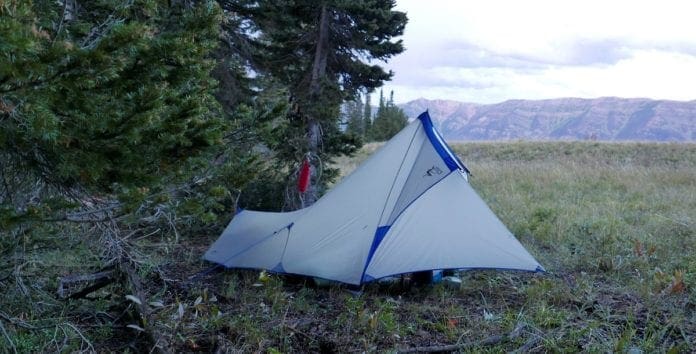
Stone Glacier SkyAir ULT
In an ever-increasing pursuit to minimize weight and bulk, hunters have been borrowing heavily from the ultralight backpacking crowd. From the use of feather-weight quilts to Dyneema fiber stuff sacks, some backpack hunters obsess over eliminating excess weight from their sleep system, kill kit, and consumables. One area where weight can be shaved is in the shelter choice. Floorless, single-walled types of shelters can offer significant savings over a standard backpacking tent; a small tarp-like shelter can eliminate even more.
Understanding Tarp Shelters
These small tarp shelters have their limitations. The end-user needs to have advanced skills to utilize them in conditions outside of normal summer seasons. For instance, pitching them to maintain stability. This usually requires one or more trekking poles and multiple guy-out lines. Also important is orientation to oncoming weather. Anticipated weather should determine the pitch height of the tarp to allow for adequate ventilation on humid nights. It’s also important for blocking wind-driven rain during a thunderstorm.
Over the years I’ve had the pleasure, and sometimes pain, to use a bunch of minimalist types of tarps. Some were a rectangle, others rectangular with a catenary cut, while others were even more complex in shape like a three-sided lean-to. This spring Stone Glacier released the SkyAir ULT minimalist shelter which was sent to me as a test shelter.
The basic specs on the single wall SkyAir
The Stone Glacier SkyAir ULT boasts a minimal trail weight of 8 ounces with a footprint of 27-32 sq. ft. and a height of 41-47 inches at the peak of the entrance, depending on pitch height. There is the ability to add other parts for various conditions such as a vestibule, footprint, and mesh insert for bug season. The main body is a 10D silnylon fabric and comes with guy-out lines and six stakes. The full list of specs can be found here.
Use
The six stakes supplied with the SkyAir is the bare minimum needed to pitch the shelter. I’ve added an additional four MSR Groundhog stakes to the kit for a more secure pitch in windy conditions. This brings my most common configuration of the main body, vestibule, groundsheet, and 10 stakes to 1.32 pounds. The mesh insert is a silnylon floor with a bug net upper weighing 0.70 pounds, which I used during bug season as a replacement to the groundsheet. The weight of the trekking poles has been left out of the total as readers can factor in the weight of their personal poles for a total shelter weight. To eliminate the use of trekking poles, natural material like a thick tree limb can be cut on-site. 100 -130 cm is the recommended length depending on the desired overall height.
Stone Glacier SkyAir Set Up
The initial setup of the tarp is fairly straightforward, but as with most floorless shelters, it is a good idea to practice a few times at home before trying it under more arduous conditions. Efficiency for me came after half a dozen setups and became routine as the season got underway. The process for me starts by staking the foot end down and then inserting the front trekking pole and staking out the front guy lines. Next, I stake down and tension the main ground loops of the shelter body, next the rear pole, and then the additional guy-out lines for a tight pitch.

Throughout the summer and fall test period, I’ve settled on the tallest pitch for more headroom versus a lower, wider stance. The trekking poles I carry are fixed length, so I slip a rock under the pole to achieve the needed height. Configuring the rear trekking pole with a half hitch in the guy-out line didn’t work well with my poles. Instead, I used a split tree limb about 15 inches long and routed the line over the fork and down to the stake for a solid pitch. After the shelter is staked out and taut, I insert the footprint and secure it in place by slipping the corner loops over the outside stakes and tension them to the pitched width.

The mesh insert can be used without the footprint and it clips into place via a few small loops in the tarp body. It can be attached before pitching or after and can remain attached for future use in buggy environments. My primary use for the mesh insert was in the summer months, but once September rolled around, it was bug-free and I didn’t have a need for it.
PERFORMANCE
The SkyAir system performed really well in the varied climates of central British Columbia, western Montana, and western Wyoming. All have unique conditions to contend with and the tarp system performed very well in them all.
Summer Trip
The primary use in BC was a summer trip to the northern end of the Caribou range where insects and constant rain can be a challenge for any shelter. For this trip I had the mesh insert installed with the vestibule for more weather protection. The shelter held up to the wind events encountered and the shelter remained dry inside even with continuous rain. The fabric dried quickly when the sun emerged and the tiny size of the stored shelter was welcome when space was limited on this trip. There was very light condensation in the shelter in this high humidity environment and at times the wind would blow hard enough to stick the mesh to the tarp. Eventually, it would touch the foot of my bag and get it damp. It was never a major problem; just an annoyance.

Montana
The use in Montana was a mixture of summer hiking trips with high humidity and rain to clear September backcountry elk hunts. During these trips, I left the mesh insert at home. I used the footprint as a barrier between the wet ground and my sleep system and other gear. The shelter maintained its weatherproof qualities and ventilated really well when pitched in a tall configuration. It did have some overnight condensation when pitched in really wet vegetation on calm, cool nights. The vestibule is large enough to store gear that’s not in the tent body and simultaneously cook in as well. I did not use the SkyAir without the vestibule. I think its benefits far outweigh the few ounces it adds to the setup.
Wyoming
September conditions in Wyoming were typical of high elevation hunts across the west. They varied from hot and dry to dramatic afternoon thunderstorms. The thunderstorms generated some incredibly strong and variable downdrafts that really tested the stability of the shelter. There were a few times when I wasn’t sure things would stay upright or dry but everything performed perfectly. This hunt was a classic bivy hunt with camp on my back every day as I moved around hunting areas. This is where the small pitched footprint really helped as there were few places that were blowdown free, flat, and large enough for a shelter.
Pitch Location
A flat location is crucial when using the footprint in the SkyAir as it is incredibly slippery. This is my only real dislike of the system; if there is any slope at all, be prepared to slide in that direction. Stone Glacier applied small sticky dots to the top of the footprint to combat this, but they are not effective.
OVERALL THOUGHTS
The SkyAir ULT is a great shelter system for anyone looking for a solo ultralight shelter. It takes up very little noticeable space in a pack and weighs just less than most 20-degree sleeping bags. And, it pitches with a small footprint and is stable in heavy winds. It has proven to be a weatherproof shelter even in wind-driven thunderstorms. The stitching on the seams and guy-out points have remained undamaged and the body and footprint fabric did as well.
The use of this shelter, and others like it, is for more skilled backcountry users. It’s not super intuitive to pitch (but not hard). And it can be hard to stay mentally positive when using it in long periods of inclement weather. That’s due to it being fairly tight when packed with gear. The mesh insert is worth adding to the setup if insects are a concern. And the footprint, even with its problem of being slippery, is worth adding to the shelter if the ground conditions are really wet. Overall it is a very versatile shelter for early and midseason hunts. The SkyAir will find its way into my pack in the future. Order yours here.
PRICE BREAKDOWN
- SkyAir ULT tarp: $165
- Flat Footprint: $69
- Vestibule: $49
- Mesh Insert: $125
You can comment on this review or ask Josh questions here.
Here are a few more great shelter reviews.





















